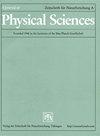Nonlinear optical response of Li n ClK (n = 1–6) superalkali clusters
IF 1.8
4区 物理与天体物理
Q4 CHEMISTRY, PHYSICAL
Zeitschrift Fur Naturforschung Section A-A Journal of Physical Sciences
Pub Date : 2023-10-30
DOI:10.1515/zna-2023-0177
引用次数: 0
Abstract
Abstract The geometrical structures, stabilities, electronic properties and nonlinear optical response of the halogen doped bimetallic Li n ClK ( n = 1–6) clusters were studied within the density functional theory. Based on the dissociation energy, second order energy difference and GH-L (HOMO-LUMO gap), the Li n ClK ( n = 2, 4, 6) clusters are more stable. According to their ionization energies, the clusters can be classified as a superalkali. From the NBO analysis, the clusters are excess electron systems. The obtained first static hyperpolarizability ( β o ) values are in the range of 1.56 × 10 4 − 4.33 × 10 4 au while the second static hyperpolarizability vary within 2.47 × 10 6 au to 13.9 × 10 6 au for the Li n ClK ( n = 1–6) superalkalis that are slightly higher than the nonlinear optical response of halogen doped monometallic clusters. More importantly, the Li 5 ClK is transparent in the deep UV region ( λ < 300 nm) among the superalkalis indicating that the Li 5 ClK superalkali can be a candidate structure as new member of NLO materials.Li n ClK (n = 1-6)超碱簇的非线性光学响应
摘要利用密度泛函理论研究了卤素掺杂双金属Li n ClK (n = 1-6)簇的几何结构、稳定性、电子性质和非线性光学响应。从解离能、二阶能差和GH-L (HOMO-LUMO间隙)来看,Li n ClK (n = 2,4,6)簇更稳定。根据它们的电离能,这些团簇可以被归类为超碱。从NBO分析来看,这些团簇是多余的电子系统。Li n ClK (n = 1-6)超碱的第一次静态超极化率(β o)在1.56 × 10 4 ~ 4.33 × 10 4 au之间,第二次静态超极化率在2.47 × 10 6 au ~ 13.9 × 10 6 au之间,略高于掺杂卤素的单金属团块的非线性光学响应。更重要的是,Li 5 ClK在深紫外区是透明的(λ <表明Li 5 ClK超碱可以作为NLO材料新成员的候选结构。
本文章由计算机程序翻译,如有差异,请以英文原文为准。
求助全文
约1分钟内获得全文
求助全文
来源期刊
CiteScore
3.00
自引率
5.60%
发文量
81
审稿时长
3.3 months
期刊介绍:
A Journal of Physical Sciences: Zeitschrift für Naturforschung A (ZNA) is an international scientific journal which publishes original research papers from all areas of experimental and theoretical physics. Authors are encouraged to pay particular attention to a clear exposition of their respective subject, addressing a wide readership. In accordance with the name of our journal, which means “Journal for Natural Sciences”, manuscripts submitted to ZNA should have a tangible connection to actual physical phenomena. In particular, we welcome experiment-oriented contributions.

 求助内容:
求助内容: 应助结果提醒方式:
应助结果提醒方式:


